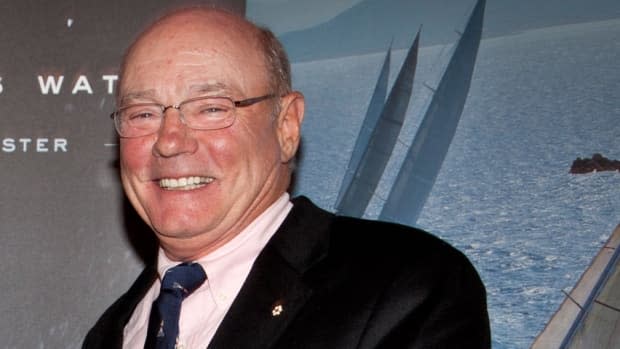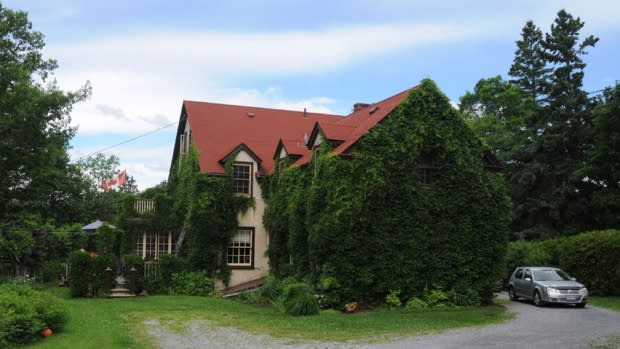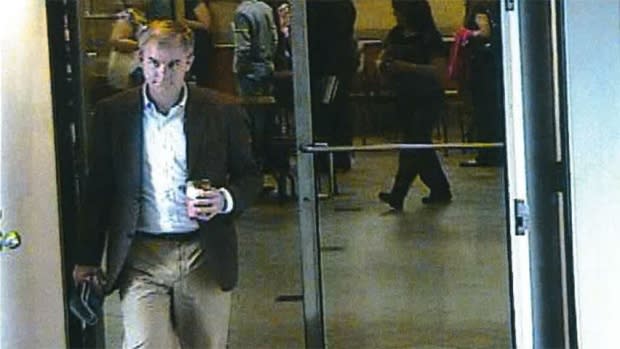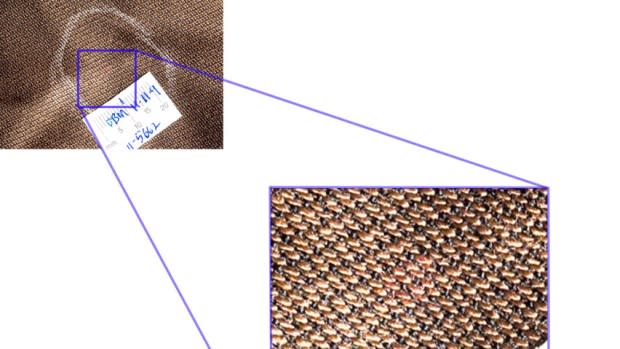Why Dennis Oland was found not guilty of murder at his retrial
Dennis Oland plans to spend quality time with his family today, his first full day as a free man in more than eight years.
Oland, 51, has been living under a cloud of suspicion since the day his father's bludgeoned body was discovered in his Saint John office in 2011.
On Friday in Saint John, Justice Terrence Morrison of New Brunswick's Court of Queen's Bench found Oland not guilty of second-degree murder at his retrial in the death of his father, Richard Oland.
Morrison's oral ruling took only 15 minutes, but his written decision is 146 pages, much of it "technical" and "scientific."
Unlike the jury that convicted Oland at his first trial in 2015, whose verdict was overturned by the New Brunswick Court of Appeal because of an error in the trial judge's instructions to the jury, Morrison had to provide reasons for his decision, based on the evidence presented at his retrial and the law.
Here are some of the key points he covered:
Motive
Although motive is not an essential element of the offence, it "provides context for the interpretation of the evidence," said Morrison.
"Without motive, the trier of fact is being asked to put the jigsaw puzzle together without the benefit of seeing the picture on the puzzle box," Morrison said.
The Crown's motive theory was three-pronged and here is Morrison's reasoning about each one:
1) Oland had a troubled relationship with his father.
Morrison said he had no doubt Oland and his father had a "difficult relationship." He noted the evidence suggested the elder Oland had a "demanding, controlling and difficult personality."
But Morrison could not conclude the relationship was "so dysfunctional" as to be abnormal. "In my view, whatever resentments the relationship may have fostered in Dennis Oland they cannot, on their own, account for Richard Oland's murder."

2) Oland "disapproved" of his father's extra-marital affair with local realtor Diana Sedlacek.
Morrison rejected this suggestion "outright." The gist of the conversation Oland had with his father's business associate Robert McFadden about the affair "hardly belies a burning resentment, let alone red-eyed rage," he said.
McFadden testified Oland told him in 2008-09, "Maybe you could mention to him to cool it, or be more discreet."
"It was a rather tepid suggestion made in a one-off, unrelated conversation at least a year and a half before the murder," said Morrison.
3) When Oland visited his father at his office on July 6, 2011, the night he was killed, he was in dire financial straits and had "nowhere left to turn" but to his father, whose investments were worth an estimated $36 million.
Morrison said "there is little doubt" Oland's financial situation "was bleak."
Between January and July 6, 2011, he spent $86,000 more than his income. He had missed two interest-only payments of $1,666.67 to his father on his $538,000 loan.
Oland also missed his June 2011 payment on his $163,000 line of credit from CIBC, which he had secured against the ancestral home. This line of credit wasn't known to his father, who wanted him to sign a mortgage and right of first refusal agreement with him over the home, the courtroom heard.
Crown prosecutors posited Oland asked his father for financial assistance during the visit, his father refused and he killed him in a state of "rage."

Morrison accepted Oland's testimony that he was not overly concerned about his financial situation, but found his testimony regarding a $16,000 advance on his salary he received from CIBC Wood Gundy where he worked as a financial adviser "simply not credible."
The judge dismissed as "unrealistic" Oland's testimony that he would have been able to "extricate himself from his financial morass" simply by increasing his book of business. "That is a long-term plan, not an immediate solution," he said.
Oland had sent an email to his supervisor on June 1 stating he expected to increase his book of business by August/September. "We are looking at total new assets in the $10-20 million range."
"The clear and unequivocal meaning of that email is that … he expected to have an additional $10-20 million invested by his father and another unnamed investor," not just that $10-$20 million was his growth target, as he testified to, said Morrison.

Still, Morrison did not find there was a "tipping point" in Oland's financial situation "that drove [him] to desperation" that night.
He said the evidence did not support the Crown's suggestion Oland's father knew about his missed interest-only payments or that it concerned him.
He also found no evidence of the Crown's suggestion Oland was at risk of losing the ancestral home, worth an estimated $650,000, to foreclosure, noting he had missed only one payment of $481.
Morrison said, even if he found Oland was in a financial crisis on July 6, the evidence showed that when Oland sought financial help in the past, his father did not refuse him.

In addition, Morrison found no evidence that Oland received any direct financial benefit from his father's death. McFadden testified the elder Oland's will provided for a spousal trust for his wife, Connie Oland, with the remainder divided among his son and two daughters only upon her death, he said.
Besides, said Morrison, financial gain as the motive for murder implies premeditation. "This would fly in the face of the Crown's theory that this was a crime of passion born of an enraged mind and would be inconsistent with the charge of second-degree murder found in the indictment."
Blood and DNA on jacket
A key piece of evidence in the Crown's case against Oland was the brown sports jacket he wore when he visited his father on the night he was killed.
Oland told police he was wearing a navy blazer that night, but video surveillance and witness testimony showed he actually wore the brown Hugo Boss jacket.
The jacket was taken to be dry cleaned the morning after Oland was questioned by police. It was later seized and found to have four small bloodstains on it and DNA matching his father's profile.
The Crown alleged Oland lied to police about which jacket he wore to mislead them.

There is "some merit" to the Crown's contention that Oland "deliberately obfuscated" certain facts during his police interview, said Morrison. He noted Oland "entirely omitted" making a third trip to his father's office that night.
But Morrison was not satisfied there was sufficient evidence to conclude Oland's untrue statement about the jacket was a lie fabricated to deceive police.
He also pointed out Oland was under police surveillance as soon as he left his police interview on July 7 and there was no evidence he attended the dry cleaners on July 8.

In Morrison's view, the bloodstains found on the jacket actually supported the defence's case more than the Crown's.
The small number and "very small" size of the bloodstains are inconsistent with the bloody crime scene, he said.
Three of the stains — two on the right sleeve and one on the upper left chest — were all less than three millimetres in size and the fourth, on the middle of the back, near the hem, was less than two millimetres, the trial heard.
Morrison contrasted that with the crime scene photos, which depicted "a gruesome and bloody murder," with blood spatter 360 degrees.
In my view, [the brown sports jacket] is a piece of circumstantial evidence favouring the accused. - Terrence Morrison, New Brunswick Court of Queen's Bench justice
The Crown argued the lack of a blood trail leaving the office and the lack of evidence of any cleanup at the scene suggested the killer walked away with little blood on him or her.
But Morrison said he accepted the opinion of the defence's bloodstain analyst who said if the brown sports jacket had been worn during the murder, it would have had "significant and visible blood spatter on it."
Although the Crown suggested the lack of blood could have been caused by the dry cleaning, the judge said there is "a dearth of evidence as to the effect of dry cleaning on bloodstained clothing."
In addition, the dry cleaners testified they examine clothing items for stains before they clean them and did not note any bloodstains on the jacket.

Any suggestion the jacket was washed "falls into the realm of impermissible speculation," he said.
There is no evidence to support the killer donning coveralls either, said Morrison.
"Indeed, the taking of such precautions would necessarily imply planning and premeditation which is antithetical to the Crown's theory of the case: a crime of passion born of an enraged mind."
The defence argued the blood and DNA was "innocent transfer" that could have pre-dated the murder.
The victim's secretary testified he had a skin condition that would make his scalp bleed and that he was touchy-feely when he talked to people. Oland had also moved into his father's home for a few months while his own house was undergoing renovations and stored his clothes in his father's closet, the trial heard.
Morrison said the absence of blood spatter on the shoes and other clothing items Oland wore when he visited his father along with the absence of blood on the reusable grocery bag he had with him, the Blackberry he used after leaving the office and the car he drove home "calls into question the inference that the blood on the jacket is blood spatter."
"In my view, [the jacket] is a piece of circumstantial evidence favouring the accused that can be considered, along with all the other evidence, in determining whether the Crown has proven guilt beyond a reasonable doubt."
Time of death
The other "pillar" of the Crown's case, said Morrison, was the time of death evidence.
The Crown argued the victim was killed sometime between 5:45 p.m. and 6:36 p.m., when Oland was alone with him in his office and would have had exclusive opportunity to kill him.
Prosecutors presented evidence that the last human interaction with the victim's main computer was at 5:39 p.m. and the last communication received by his cellphone before it went silent was a text message at 6:44 p.m.
That text was transmitted by a tower in Rothesay near the wharf where Oland stopped on his way home from visiting his father at around that same time. The cellphone was never found.
A radio frequency engineer testified the cellphone was likely in the Rothesay area at the time because cellphones are designed to connect with whichever tower provides the strongest signal and as a general rule, that's the closest one.

Morrison described the digital evidence as "persuasive." The lack of computer interaction was "probably because something was amiss," he said. Diana Sedlacek had tried to text and call the victim several times, without success, suggesting Oland "was likely not responding … because he was unable," said Morrison.
He also accepted the engineer's opinion that it was unlikely a cellphone located in uptown Saint John would connect with a cell tower in Rothesay, about 14 kilometres northeast.
However, the evidence was not conclusive, he said.
Thumping noises
The men who heard "thumping" noises coming from the victim's office on the night he was killed also raised a reasonable doubt as to the time of death, said Morrison.
The only reasonable inference is that the noises heard by Anthony Shaw and John Ainsworth were the killing, he said. "Indeed, the Crown concedes the point."
Shaw's "guesstimate" for when he heard the noises was around 7:30 p.m., which Morrison deemed "reliable" evidence.
Ainsworth testified he could only estimate the noises were sometime between 6 p.m. and 8:11 p.m., but in a previous videotaped sworn statement to a private investigator hired by the defence, he put the timing at between 7:30 p.m. and 7:45 p.m.
Morrison said he accepted Ainsworth's previous statement over his testimony.

He also found "some — albeit tenuous" support for the 7:30-8:00 p.m. timeframe came from Saint John Harbour MLA Gerry Lowe, who said he saw a man exit the door that led to the victim's second-floor office while he was eating at the restaurant across the street.
Lowe, a regular patron of Thandi restaurant, was uncertain which night he saw the man. But he recalled being with a female companion and seeing a photo shoot that night.
Security video showed Lowe was at the restaurant with a woman on July 6 between 7:40 p.m. and 8:35 p.m., and an agreed statement of facts showed there was a photographer doing a marketing shoot there that night, arriving at 7:46 p.m.
The defence had security video of Oland shopping with his wife in Rothesay by 7:38 p.m. If his father was killed any time after approximately 7 p.m., then Oland "could not have been the killer," the judge said.
Therefore, "notwithstanding the credibility and reliability" of Shaw's evidence, Morrison said he could not "wholeheartedly accept it."
"In short, I have a reasonable doubt as to whether Richard Oland was killed prior to 6:44 p.m. or when Mr. Shaw says he heard the murder at 7:30 p.m. In the circumstances of this case, if I have a reasonable doubt as to the time of death, I must acquit the accused."
Public Prosecution Services has not yet decided whether to appeal. It has 30 days to file.
Oland, a married father of four, served about 10 months in prison before the New Brunswick Court of Appeal quashed his conviction on Oct. 24, 2016 and ordered a new trial. He was released on bail the following day and has been living in the community under conditions ever since.
Oland has maintained his innocence from the beginning. "I'm not that kind of monster," he testified.

